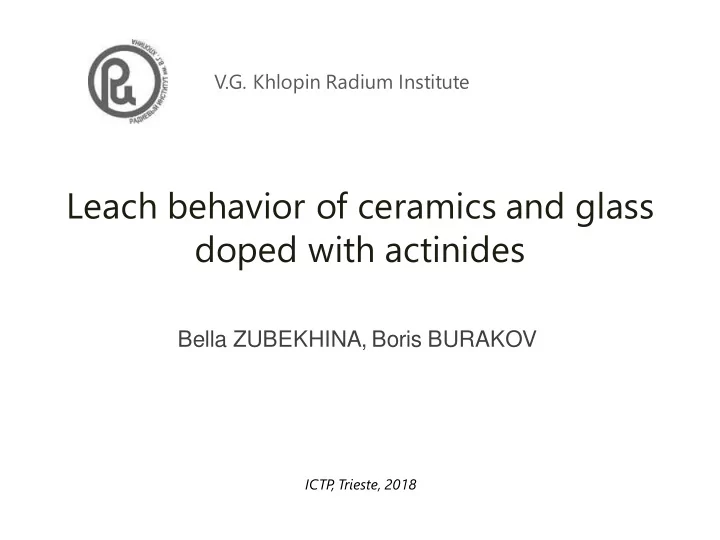

V.G. Khlopin Radium Institute Leach behavior of ceramics and glass doped with actinides Bella ZUBEKHINA, Boris BURAKOV ICTP , Trieste, 2018
HLW management in Russia More than 500 million m 3 of radioactive waste accumulated in • Russian Federation ( according the data of National Operator of Radioactive Waste, 2017 ) LLW - 99,3% ILW - 0,67% HLW - 0,03% “ Mayak ” vitrification facility (Chelyabinsk region) • 28560 m 3 of HLW were converted into glass (1987-2010) - - 6188 tones of nuclear glass with total activity 643 000 000 Ci * * П.В. Козлов, М.Б. Ремизов. Сборник тезисов конференции «Зарождение радиоэкологии, её развитие и роль в обеспечении радиационной безопасности природной среды и человека », Озерск, 10-12 октября 2017. (in Russian)
how to study chemical durability Leaching tests Static Dynamic MCC1, PCT-A, PCT-B, … SPFT, Soxlet test, … Alteration tests Vapor hydration test (VHT) – to accelerate formation of secondary phases • Full scale and small scale experiments Sample interaction with groundwater, buffer and hostrock •
radiation effects in solidified HLW Confirmation chemical and mechanical durability Samples of ceramic and glass synthesized 30-40 years ago should • be available for research Prediction of future behavior Computer modelling • Irradiation by heavy ions • Accelerated radiation damage by 238 Pu or 244 Cm •
synthesis of 238 Pu doped samples Only small samples 0.1 – 10 g • Pu content up to 1 wt.% for glass • up to 10 wt.% for ceramic All operations including high temperature sintering should be • carry out in shielded conditions
Heavy box Glow box Right after synthesis Checking contamination on the floor
synthesis and study of Pu-doped B-Si-glass 9/06/2016 B-Si-glass (France) • ✓ Well known material for HLW immobilization. ✓ Commercial technology based on SON68 glass composition. Sintering in air, 1400 °С, 1 hour • 0,45 wt.% 238 Pu for acceleration of radiation damages • and nonradioactive (referent) sample with almost the same composition 3 wt.% Eu for trivalent lantanides simulation •
small high temperature furnace developed at KRI 325 300 820 200 260 365 220 Patent № 14714, Vol. № 29, 20.10.2014
Sample of SON-68 glass doped with 0,4 масс.% 238 Pu right after synthesis Self glowing in darkness
leaching test Static leach test, 90° С SA : V = 1 cm 2 : 80 cm 3 Accumulated dose (on 11.11.2017) 2,5·10 23 α -decays/m 3 1,7·10 16 α -decays/sample Days 7 14 28 56 108 Pu leach rate, g/(m 2 day) 0.08 0.04 0.34 0.58 0.13
alteration at saturated conditions (1) Sample doped with 0,4 wt. % 238 Pu (left) and non-radioactive sample with the same composition (right) after contact with water at saturated conditions static conditions, 4 month, 90 °С, SA : V= 1 cm 2 : 4 cm 3 Self-destroying of the gel was observed in a week after gel formation!
alteration at saturated conditions (2) left - optical image of the alteration xerogel detached from the bulk glass. Values of axes are in microns; right – BSE images of carbon-coated xerogel detached from the glass. Whitish regions correspond to Pu-rich domains.
what kind of vessel material can be used for leaching test? Stainess steel Teflon Gold ? Platinum Titanium Quartz
Leaching of ceramics and single crystals doped with Pu based on cubic zirconia, monazite, zircon and plutonium oxide
Cubic zirconia (Zr,Gd,Pu)O 2 doped with 9.9 wt. % Pu-238 . Synthesized in 2000. Cumulative dose 1.2 ∙ 10 26 α -decay/m 3
self destruction of monazite ceramic sample 3 Pellet of single-phase 238 Pu-doped ceramic, La 0.9 Pu 0.1 PO 4, at accumulated dose approximately 10 26 alpha-decays/m 3 : 1) right after extraction from XRD sealed holder 2) piece used for leach test 3) pellet after leach test at 90 ˚C for 28 days
Normalized Pu mass loss from samples of single-phase Pu-doped ceramics after static leach tests in distilled water for 28 days. Correction for ceramic porosity was ignored NL, g/m 2 , 28 days, 90 ˚C Sample Cumulative dose, α -decay/m 3 x 10 24 Cubic zirconia Zr 0.79 Gd 0.14 Pu 0.04 O 1.93 doped with 9.9 wt.% 238 Pu Previous data [1] 1 0.04 6 0.4 8 0.4 13 0.2 Pellet #1 163 0.3 Pellet #2 170 0.7 Cubic zirconia Zr 0.75 Gd 0.19 Pu 0.06 O 1.91 doped with 9.9 wt.% 239 Pu Previous data [2,3] insignificant 0.04 Pellet #1 0.6 0.1 Pellet #2 0.6 0.1 Monazite La 0.9 Pu 0.1 PO 4 doped with 8.1 wt.% 238 Pu Pellet #1 1 0.4 Pellet #2 100 1.6
Leaching of plutonium from polycrystalline and monocrystalline PuO 2 Sample of polycrystalline 239- 238 PuO 2 contained 11% 238 Pu Cumulative dose 3 x 10 26 alpha- decay/m 3 Results of PuO 2 static leach tests: ○ and ● – polycrystalline samples (the same pellet was used in different tests); □ – single crystals (only 1 mm separate fresh samples for each test) Single crystals of 238,239 PuO 2
single crystalls to be studied 1 3 2 3 Single crystals of zircon doped with 237 Np (1) and 239 Pu (2). Single crystal of neptunium oxide (3).
synthesis and study of Ti-ceramic with HLW
All operations with liquid HLW were carried out in heavy box Sintering in air inside glow box at temperature 1200 ⁰ C Pellet of Synroc-like polyphase titanate ceramic
Leach rates* of 154 Eu, 241 Am, 244 Cm (for 10 month, dist. water, 90°C) * с alculated for geometrical surface area
small scale experiment with highly radioactive sample Started in February 2018
Thanks for your attention!
Recommend
More recommend